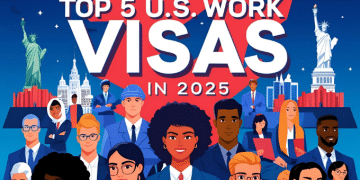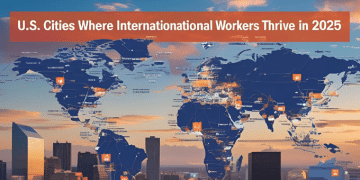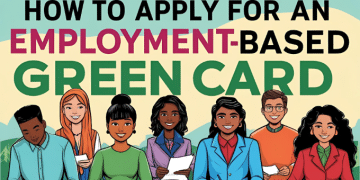OPT vs. CPT: Which Is Better for International Students?

If you’re an international student in the U.S. in 2025, you’re probably thinking about more than just classes and exams. You’re thinking about what comes next—how to get real-world work experience while still on a student visa. That’s where OPT and CPT come in. You’ve likely heard of both, but figuring out which one fits your path best isn’t always straightforward.
So let’s break it down in plain language. No fluff. No legal jargon. Just what you need to know to make the right decision.
In this guide, we’ll walk you through:
- What OPT and CPT actually are
- The differences between the two
- The pros and cons of each
- What’s new in OPT CPT USA 2025
- How each one affects your student work visa USA situation
So, What Exactly Are OPT and CPT?

OPT (Optional Practical Training)
OPT is a way for F-1 students to work in their field of study. You don’t need a job lined up when you apply. It’s available while you’re still in school (pre-completion) or after you graduate (post-completion).
Here’s what you should know about OPT:
- You need to complete at least one academic year first
- You apply through USCIS, and approval can take 2–3 months
- You get up to 12 months of work (and 24 extra months if you’re in a STEM field)
- The job must be related to your major
- You can work anywhere in the U.S.
In short, OPT gives you breathing room after graduation to get hands-on experience in your industry. It’s one of the most widely used programs under the student work visa USA category.
CPT (Curricular Practical Training)
CPT is a bit different. It’s for internships or training that’s directly tied to your academic program. Unlike OPT, you’ll need a job offer before applying, and the work must be part of your coursework or a graduation requirement.
Here’s how CPT works:
- You also need to complete one full academic year (unless your grad program allows earlier access)
- It’s approved by your school—not USCIS
- The job must be tied to your curriculum and count for credit or fulfill a requirement
- You can do it part-time or full-time, but too much full-time CPT can cost you your OPT eligibility
So CPT is great for internships during your degree, but once you graduate, it’s off the table. That’s a big deal in the OPT CPT USA 2025 decision-making process.
Read next: H1B vs L1 Visa: Key Differences, Requirements & Which Is Better in 2025
OPT vs. CPT at a Glance
| Feature | OPT | CPT |
| When You Can Use It | Before or after graduation | Only while you’re still enrolled |
| Who Approves It | USCIS | Your school (DSO) |
| Job Offer Required? | No | Yes |
| Part of Curriculum? | No, just needs to be related | Yes, must be course-integrated |
| Duration | 12 months (36 for STEM) | Varies based on your program |
| Approval Time | 2–3 months | A few days to a week |
What’s Changing in 2025?
The rules for OPT and CPT haven’t changed drastically, but if you’re applying in 2025, there are a few important shifts to be aware of that could affect your strategy—and your timing.
OPT applications are facing more scrutiny
USCIS is paying closer attention to how well your job matches your degree. This means you’ll need to be extra clear when showing that your employment is directly tied to what you studied. It’s no longer enough to just say it “sort of” fits.
Schools are tightening CPT policies
In the past, some schools were more flexible in how they defined an “internship.” That’s changing. Many universities now require the work to be part of a credit-earning course or officially listed in your curriculum. If your program doesn’t clearly outline work experience as part of your track, you might hit a roadblock.
More STEM majors are now eligible for the 24-month OPT extension
Fields like environmental engineering, data analytics, AI, and biotechnology are seeing updates to the STEM Designated Degree Program List. That’s great news if you’re in one of those fast-growing areas.
All of this adds up to one message: you’ve got to plan ahead. Relying on what worked for students a year or two ago might not work for you now. The expectations are higher, and the process is more detail-focused.
So if you’re unsure about your next step, talk to your DSO early. Don’t wait until the last minute to figure out your eligibility or start filling out forms. The international student office is there to help you map this out—and the earlier you loop them in, the smoother the process will be. If you’re not sure where to start, talk to your school’s international office. They’re there for exactly this reason.
Read next: Top 5 Work Visas for International Workers in 2025
OPT: Why It Might Work for You
Upsides:
- No job offer needed to apply
- Great for post-grad work experience
- Opens the door to longer-term work visas like the H-1B
- Gives you a shot at staying in the U.S. after graduation
Downsides:
- USCIS approval can take months—so apply early
- Limited to 12 months (unless you’re STEM)
- Missing a deadline could mean losing your chance
If you’re planning to build a career in the U.S., OPT is a strong option in the student work visa USA route.
CPT: Why It Could Be a Smart Move
Perks:
- Faster approval—your school handles it
- Helps you build a resume before you graduate
- Lets you earn credit while getting real experience
Things to Watch Out For:
- You need a job offer up front
- Full-time CPT for 12 months = no OPT later
- You can’t use CPT after you finish your program
CPT is perfect if your program includes internships and you want to get your foot in the door early.
Which One Should You Pick?
Ask yourself a few honest questions:
- Still in school and need internship credit? CPT is probably your best move.
- Graduating soon and want to start working right after? OPT gives you more time.
- In a STEM field? OPT’s 24-month extension might give you a real advantage.
The right path depends on your timeline, your goals, and how much planning you’re willing to do. There’s no one-size-fits-all answer here.
Application Tips You’ll Be Glad You Followed
- Don’t procrastinate. These processes take time—get started early.
- Talk to your DSO. Seriously. They’ve seen every situation before.
- Double-check everything. Typos and missing documents can delay things by weeks.
- Stay organized. Keep a folder with all your forms, receipts, and approvals.
- Use official sources. Stick with USCIS and your school. Reddit isn’t a policy manual.
Read next: Complete Guide to H1B Visas: Requirements, Process, and Cost
Final Take
No matter where you are in your academic journey, both OPT and CPT can open doors. The trick is knowing when and how to use them.
CPT helps you build experience while you’re still in class. OPT gives you the runway to start your career after graduation. Both can help you stay on track with your student work visa USA goals.
Take your time, ask for advice, and make the decision that fits your future. With a little planning, you’ll be ready for whatever comes next.





